

So for Timer2, the time it will overflow will be: The Arduino UNO board has a 16 MHz oscillator and the clock divisor is 64 by default. Hence, this is the Timer2 overflow time formula:

The 'x' here is the timer number and so for Timer2, the register is TIMSK2:Įxactly when the overflow occurs depends on the oscillator frequency and the clock divisor. Setting the TOIE bit on each timer’s interrupt mask register, TIMSKx, enables timer overflow interrupt. For Timer2, overflow occurs when the count goes beyond 255, bringing it back to 0. Timer overflow is a condition where the timer has counted beyond its maximum number. The first way is by checking if the timer has overflowed. Just like the other timers, there are three ways to use Timer2 for interrupts. Specifically, I will use Timer2 for timer overflow and compare interrupts and Timer1 for capture interrupt.
#Arduino timer interrupt stack overflow how to#
Also, these timers make PWM generation possible.įor this tutorial, I’ll only show how to use Timer2 and Timer1 for interrupt since Timer0 is already used by millis().

Both Timer0 and Timer2 are 8-bit timers (can count from 0 to 255) while Timer1 is a 16-bit timer (0 to 65535).Īrduino timer interrupt programming is possible for each timer, besides providing timing and pulse counting. The Arduino UNO’s ATMega328p has 3 timers at its disposal: Timer0, Timer1 and Timer2. In this article, we’ll look at how to use Arduino timer interrupt. There, I showed an example where pressing a button halts the normal program execution any time and serves another routine (Interrupt Service Routine or ISR). On my previous Arduino Interrupt tutorial, I showed how to use the external and pin change interrupts for the ATMega328p-based Arduinos.


 0 kommentar(er)
0 kommentar(er)
